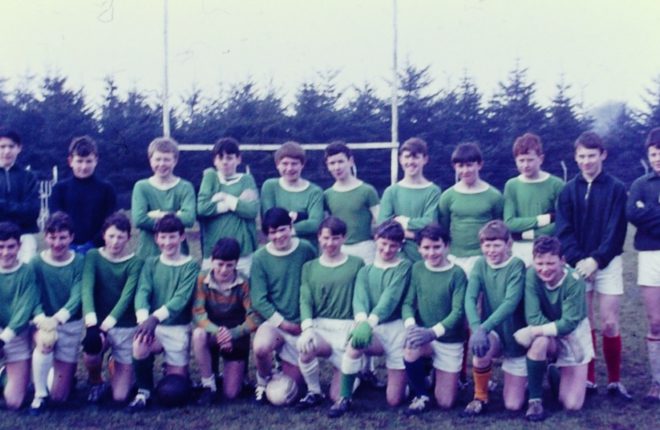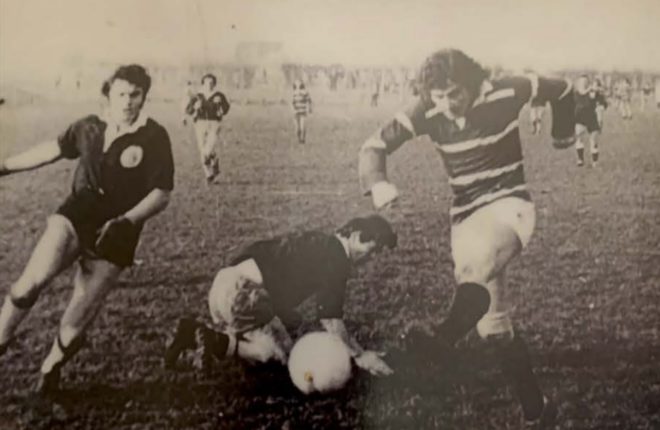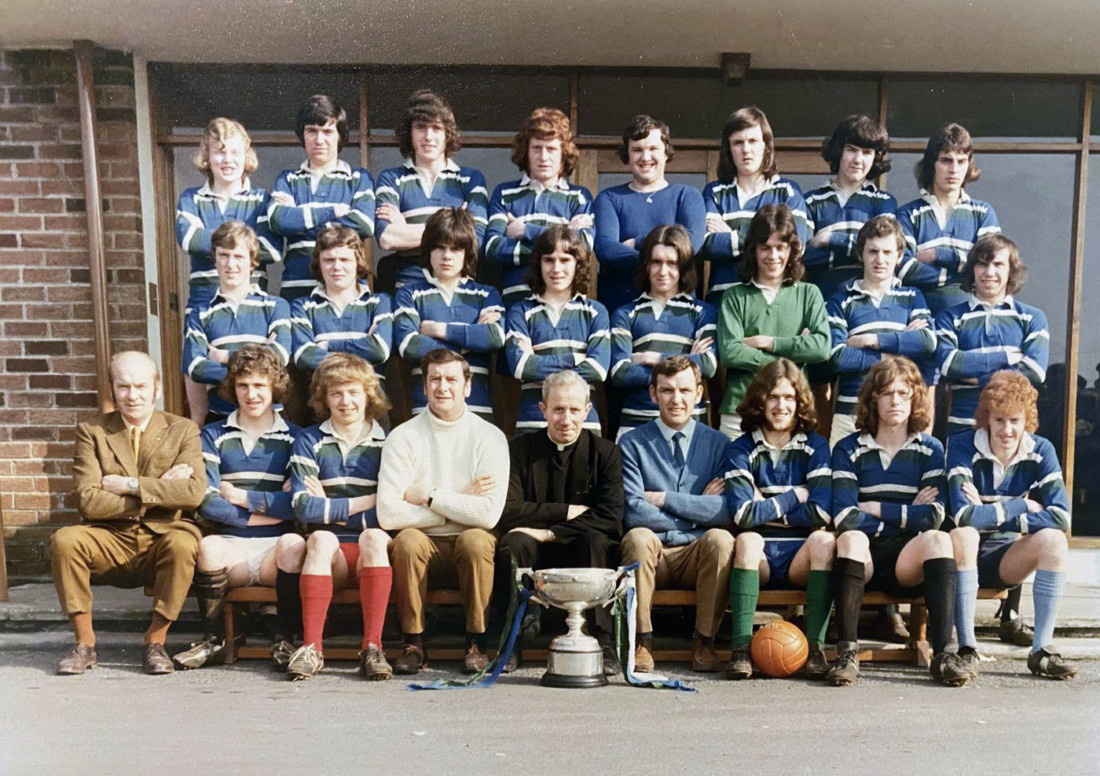Fifty years ago, St Michael’s, Enniskillen won their first ever MacRory title. Dermot McManus and Frank Cassidy were part of that historic winning team. Michael McMullan chatted with them about a memorable year.
THE seeds of the historical 1973 season were yet to be sown, but St Michael’s, Enniskillen had a decision to make. It was no ordinary decision. It would define their season and ensure that the Fermanagh GAA hub would write their first major chapter.
The school hierarchy floated the idea of dropping down to the MacLarnon Cup as a step on the development pathway.
St Michael’s had danced on MacRory final day four times before leaving empty handed, including three years on the trot from 1968 to 1970.
The middle year saw them come closest. A referee decision still irks them from a turning point in the game. Also, Gerry Gallagher’s shot came back off the crossbar before being cleared in a game St Colman’s edged by three points.
Earlier that day, St Michael’s beat Colman’s to land a first ever Corn na nÓg title which was backed up with Rannafast success two years later.
By 1972, they had a team bubbling towards the top, capable of seriously challenging for the biggest prize of all, but eventual Hogan Cup champions St Patrick’s, Cavan dished out a reality check, beating them 5-17 to 0-9.
Dermot McManus never forgot it, reciting the score like it was yesterday. Frank Cassidy is the same.
It led to the turning point of their 1973 march to glory before a ball was even kicked.
“We were completely stuffed and we had players like Peter McGinnity, Malachy McAleer, Brendan McCaffrey, but were completely outclassed,” McManus recalls of their 1972 lesson.
McGinnity and McAleer were among those to move on. Would those left behind be able to hold their own in the MacRory Cup? The players were given their say.
“A few of us felt we should give it another whack,” McManus adds. “We were allowed to have a vote without any teachers in the dressing room. Boys with some experience persuaded those coming into the panel, ‘let’s give it a whack’ and we won the vote.”
McManus doesn’t recall the vote being close. Cassidy remembers a group wanting to go down fighting for top honours rather than accepting the level below.
Both men were at the coalface of organising Friday’s reunion of the squad. But it’s more than that. The invite was sent out to all the St Michael’s teams who reached finals.
“The 1973 winning mind-set would not have been achievable without them,” Cassidy explains of their importance.
“We didn’t know what a Corn na nÓg title was until we won it,” McManus said of the foundation to their MacRory success.

WHERE IT ALL BEGAN…The St Michael’s Enniskillen winning Corn na nÓg team of 1969
“As you walked up the corridors and saw the photos of St Michael’s teams, you were always thinking you’d like to play at that level of competition.”
When the 1973 MacRory journey started, Clones was the first stop for a group game against none other than Hogan Cup champions Cavan.
McManus and Adrian McGonigle bagged goals as the St Michael’s attack began to click in a 2-9 to 1-8 win.
“The teachers were our drivers back then; we didn’t use buses and they brought us to all the games. They were great supporters and went mad at the end that day and it proved our point in staying in the MacRory.”
A blustery day in Ballyshannon couldn’t stop a facile win over St Eunan’s, Letterkenny with half a dozen Hugh O’Neill points and 1-2 from goal machine McManus.
The final group game was a feisty encounter in Trillick with Omagh CBS coming through by a single point from the boot of Mickey Harte.
The result was irrelevant with both teams qualified for the last eight but Cassidy rues hitting the crossbar with a goal chance. St Michael’s would also have the injured Frank McPhillips to come back into the reckoning for the knock-out stages.
“You get a confidence that you are not out of your depth and that you are at the top table,” Cassidy said.
The forwards “clicked” in a facile quarter-final win over St Patrick’s, Downpatrick, with McManus finding the net twice in a 2-13 to 1-5 victory.
The semi-final was a different story in a bruising encounter against St Mary’s, Belfast with St Michael’s coming through on the right side of a 1-5 to 1-3 scoreline
“It was a sense of either the forwards or the defence played well,” said McManus, who scored yet another goal, with captain O’Neill adding four points.
“The Belfast team’s tactics were to bury any of the forwards, especially the speedsters on the wing…we were being lifted out of it,” McManus recalls.
“The defence were in top, top form that day and all the forwards thanked them after the match for getting us through to the final because we didn’t perform that well in the forward line.”
An important ingredient in the St Michael’s story were the boarders who brought colour and energy in support of the team.
Long-term Fermanagh sponsor Patsy Tracey was one of the crew that gathered money and arranged to have flags made to add to the occasion.
“The boarders contributed to it very well,” Cassidy remembers. “Whether the games were in Clones, Coalisland, Dungannon or wherever…the carnival came to town on a Saturday for a match.”
It added to the build-up for their rematch with Omagh in the final. History beckoned and they’d a point to prove.
“We knew we had a battle with them in Trillick (in the group game) and now we would prove it to ourselves,” McManus looks back.
“We got the first two points in that game and it settled our nerves so we knew we were up for it. Dominic Campbell marked Mickey Harte and held him scoreless which was a big achievement because he was a great forward.”
It took Cassidy’s goal before half time to swing the 1-10 to 0-10 victory in Enniskillen’s favour.

GET IN…Frank Cassidy scoring the winning goal in the 1973 MacRory Cup final
“The ball broke between Eugene McKenna and me,” Cassidy said, looking back on the decisive moment. “He was coming alongside me and put a shoulder on me, but he slipped and fell.
“I was right footed, but he had pushed me onto my left, so I had no option but to take it with the left and rest is history.”
A late McPhillips point sealed victory after an Omagh fight back before the final whistle sounded to etch the St Michael’s names into school folklore.
McManus can remember the first person he met, former teammate Malachy McAleer. “You’re so lucky Dermot,” he told him. It hit home the magnitude of what had happened.
“We had done something no other team in St Michael’s history had done,” McManus said. “The teachers were going clean mad on the sideline and the pitch was invaded. Our backs were sore from the slaps we were getting…it was great.”
St Michael’s went close in the Hogan Cup semi-final and were back in the MacRory decider 12 months later when Omagh turned the tables to win by two points after a replay.
It took until 1992 for the MacRory Cup to make its return to Enniskillen and the most recent of seven titles capped with Dominic Corrigan’s side going on to lift a first Hogan Cup in style.
When St Michael’s won in 1999, Dermot’s son, Gavin McManus, was corner-back to make it the first father and son combination to have played on winning MacRory teams in the school.
Four players from their 1973 team have since passed away and their memory will live on at Friday’s reunion – Hubert Collins, Pearse O’Neill, Seamus Carron and Fr Pat McHugh.
Assistant manager Gabriel Brock has also passed away, with a cup presented in his name every year by Ulster Schools.
Former Fermanagh star, the late Mick Brewster, managed the team and Cassidy is full of praise for his style.
“In my eyes, he was unique,” Cassidy began. “He had different training systems and he thought about the game differently and he played the game differently.”
In an era when many training sessions entailed a line of forwards kicking balls for scores and the defenders belting them back out again, followed by a handful of sprints and a game, Brewster was different.
There was no roaring or shouting. Players who made a mistake knew they made a mistake and didn’t need a barrage as a reminder.
The maths teacher in him made him “methodical” and he carried the respect earned from years of playing at the top level.
“There were two or three things he taught us and he engrained them,” Cassidy offers of Brewster’s inner workings.
Players would revert to type in the white heat of pressure in a game. A goalkeeper or full-back would rarely look up before hammering the ball over the sideline, as far away from danger as possible, but Brewster turned it into a tactic.

THREE AMIGOS…Dermot McManus (Vice Captain), Mick Brewster (Manager) and Hugh O’Neill (Captain) pictured with the MacRory Cup at their 1973 celebration dinner in Enniskillen
“The half-forwards knew that’s where it was going before it was kicked, so they ran to that position and the ball arrived in their arms,” Cassidy said of their ploy.
“He always had this outlook where it needed to be simple. If you were under pressure and a few points down with a few minutes left, players often lose the run of themselves.”
The MacRory Cup was 13-a-side in those days and Brewster also used his approach to good effect. The three half-forwards hugged midfield, creating space for two inside forwards to work their magic with support runs adding to the mix. All eight goals on their way to the cusp of the 1973 Hogan Cup final came from players in the front five.
“That was practiced all the time,” said Cassidy, their MacRory final goal hero.
“There was a mathematical approach to it all and the numbers don’t lie. If you create the system and if everyone knows it and works to it…then it works.”
“Gabriel Brock and Canon Macartan McQuaid were all involved in those teams and there were others,” Cassidy added.
“It’s so important in the colleges football to have an all-round team and the ’73 team was an all-round team, there were no weaknesses.”
Peter McGinnity and Dominic Corrigan were synonymous with St Michael’s teams, but have since moved on. Friday night will be a celebration of what the MacRory Cup has brought to the school since those humble beginnings.
And it all began with Mick Brewster and the men of ’73 who built on what came before them, swapping hard luck stories with the belief a Corn na nÓg title helped instil.
“There was some drag in confidence because St Michael’s had been to the well so often and never got as much as a bucket of water,” Cassidy laughed, referring to the losing record in finals.
He remembers standing behind the goals as a primary school child watching Peter Rooney hit three goals for St Colman’s in the 1968 final.
Two years later, a Corn na nÓg semi-final replay win over St Malachy’s, Belfast in the mountains of Pomeroy led them to a final and victory over St Colman’s. St Michael’s were within stepping distance of the top table after all.
Friday is a night when the school GAA family can take stock, embrace and look forward.
The tradition is now firmly inrained and another squad in September dream of being on their eighth winning team.
Receive quality journalism wherever you are, on any device. Keep up to date from the comfort of your own home with a digital subscription.
Any time | Any place | Anywhere












